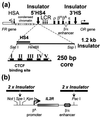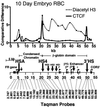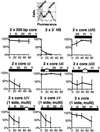Position-effect protection and enhancer blocking by the chicken beta-globin insulator are separable activities
- PMID: 12011446
- PMCID: PMC124498
- DOI: 10.1073/pnas.102179399
Position-effect protection and enhancer blocking by the chicken beta-globin insulator are separable activities
Abstract
The 1.2-kb DNA sequence element (5'HS4) at the 5' end of the chicken beta-globin locus has the two defining properties of an insulator: it prevents an "external" enhancer from acting on a promoter when placed between them ("enhancer blocking") and acts as a barrier to chromosomal position effect (CPE) when it surrounds a stably integrated reporter. We previously reported that a single CTCF-binding site in 5'HS4 is necessary and sufficient for enhancer blocking. We show here that a 250-bp "core" element from within 5'HS4 is sufficient to confer protection against silencing of transgenes caused by CPE. Further dissection of the core reveals that 5'HS4 is a compound element in which it is possible to separate enhancer blocking and barrier activities. We demonstrate that full protection against CPE is conferred by mutant 5'HS4 sequences from which the CTCF-binding site has been deleted. In contrast, mutations of four other protein binding sites within 5'HS4 result in varying reductions in the ability to protect against CPE. We find that binding sites for CTCF are neither necessary nor sufficient for protection against CPE. Comparison of the properties of 5'HS4 with those of other CTCF-binding enhancer-blocking elements suggests that CPE protection is associated with maintenance of a high level of histone acetylation near the insulator, conferred by insulator binding-proteins other than CTCF.
Figures





References
-
- Gerasimova T I, Gdula D A, Gerasimov D V, Simonova O, Corces V G. Cell. 1995;82:587–597. - PubMed
-
- Bell A, Boyes J, Chung J, Pikaart M, Prioleau M-N, Recillas F, Saitoh N, Felsenfeld G. Cold Spring Harbor Symp Quant Biol. 1998;63:509–514. - PubMed
-
- Bell A C, West A G, Felsenfeld G. Science. 2001;291:447–450. - PubMed
-
- Chung J H, Whiteley M, Felsenfeld G. Cell. 1993;74:505–514. - PubMed
-
- Bell A, West A G, Felsenfeld G. Cell. 1999;98:387–396. - PubMed
MeSH terms
Substances
LinkOut - more resources
Full Text Sources
Other Literature Sources
Research Materials
Miscellaneous

